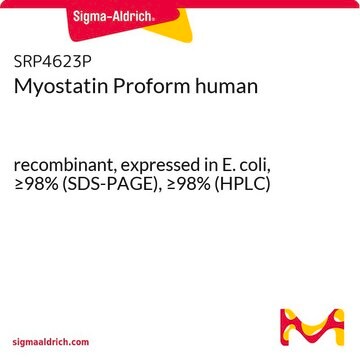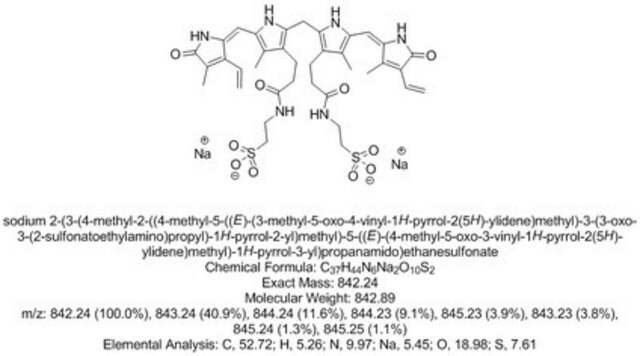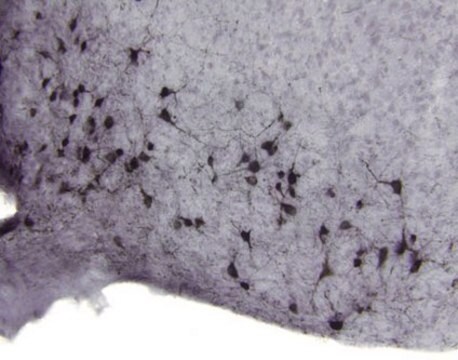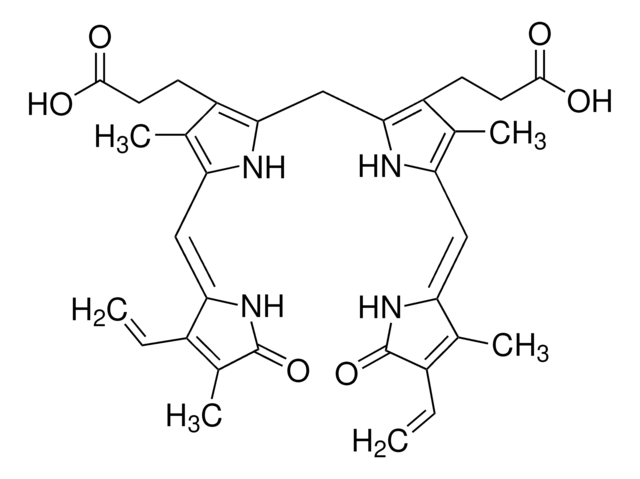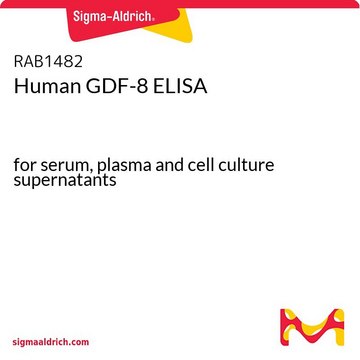M3064
Myostatin human
recombinant, expressed in E. coli, lyophilized powder, suitable for cell culture
Synonyme(s) :
Growth Differentiation Factor - 8
Se connecterpour consulter vos tarifs contractuels et ceux de votre entreprise/organisme
About This Item
Produits recommandés
Source biologique
human
Niveau de qualité
Produit recombinant
expressed in E. coli
Essai
≥95% (SDS-PAGE)
Forme
lyophilized powder
Poids mol.
16 kDa (including a 31 amino-acid spacer and 6-His tag)
Conditionnement
pkg of 0.1 mg
Technique(s)
cell culture | mammalian: suitable
Numéro d'accès UniProt
Température de stockage
−20°C
Informations sur le gène
human ... MSTN(2660)
Application
Use recombinant myostatin to study its mechanisms of action in vitro.
Actions biochimiques/physiologiques
Myostatin is a 25 KDa, homodimer, that acts on muscle to induce SMAD family transcription factors such as SMAD2 and SMAD3. It inhibits the differentiation of myoblasts into mature muscle fibers. Positive control for myostatin in Western blots and ELISA.
Positive control for myostatin in Western blots and ELISA.
Code de la classe de stockage
11 - Combustible Solids
Classe de danger pour l'eau (WGK)
WGK 3
Point d'éclair (°F)
Not applicable
Point d'éclair (°C)
Not applicable
Équipement de protection individuelle
Eyeshields, Gloves, type N95 (US)
Faites votre choix parmi les versions les plus récentes :
Déjà en possession de ce produit ?
Retrouvez la documentation relative aux produits que vous avez récemment achetés dans la Bibliothèque de documents.
Karima Relizani et al.
Molecular therapy : the journal of the American Society of Gene Therapy, 22(8), 1423-1433 (2014-05-28)
Myostatin regulates skeletal muscle size via the activin receptor IIB (ActRIIB). However, its effect on muscle energy metabolism and energy-dependent muscle function remains largely unexplored. This question needs to be solved urgently since various therapies for neuromuscular diseases based on
H Takahashi et al.
Domestic animal endocrinology, 48, 62-68 (2014-06-08)
The purpose of this study was to determine whether myostatin alters glucose transporter-4 (GLUT4) expression in bovine skeletal muscles and myoblasts isolated from double-muscled (DM) and normal-muscled (NM) Japanese Shorthorn cattle. Plasma concentrations of glucose were lower in DM cattle
Qiang Zhang et al.
The FEBS journal, 277(2), 466-476 (2009-12-18)
The ubiquitin ligase RING finger protein 13 gene (RNF13) was first identified in a screen for genes whose expression is regulated by myostatin in chicken fetal myoblasts. In this study, we demonstrate that the RNF13 gene is broadly expressed in
R E Ferrell et al.
Genomics, 62(2), 203-207 (1999-12-28)
Myostatin is a recently identified member of the transforming growth factor-beta family of regulatory factors, also known as growth and differentiation factor 8 (GDF8). The nucleotide sequence of human myostatin was determined in 40 individuals. The invariant promoter contains a
Yutaka Ohsawa et al.
PloS one, 10(7), e0133713-e0133713 (2015-08-01)
Myostatin, a muscle-specific transforming growth factor-β (TGF-β), negatively regulates skeletal muscle mass. The N-terminal prodomain of myostatin noncovalently binds to and suppresses the C-terminal mature domain (ligand) as an inactive circulating complex. However, which region of the myostatin prodomain is
Notre équipe de scientifiques dispose d'une expérience dans tous les secteurs de la recherche, notamment en sciences de la vie, science des matériaux, synthèse chimique, chromatographie, analyse et dans de nombreux autres domaines..
Contacter notre Service technique